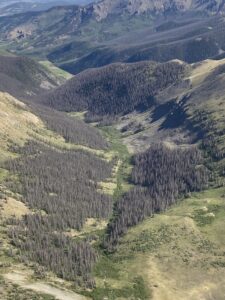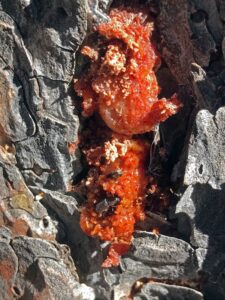LAKEWOOD, Colo., April 14, 2022 – During their annual hearing before the Colorado General Assembly, State Forester Matthew McCombs and Regional Forester Frank Beum announced a report detailing the results of the 2021 aerial detection survey led by the USDA Forest Service, Rocky Mountain Region, and Colorado State Forest Service. Every year, the agencies aerially monitor forest health conditions on millions of acres across Colorado and work together to address continued outbreaks of insects and disease, including the spruce beetle, which remains the deadliest forest pest in Colorado for the 10th consecutive year.
“This report offers a snapshot of the dynamic landscape changes that continually affect our forest lands in Colorado,” said Frank Beum, regional forester for the USDA Forest Service, Rocky Mountain Region. “By monitoring the native tree pest populations on an annual basis, land managers can better maintain healthy, resilient forests while providing timber, wildlife habitat and recreational opportunities on public and private forest lands.”

Beetle-Killed Trees on the Rio Grande National Forest – Photo courtesy of Dan West, CSFS.
Impacts from Bark Beetles
In 2021, spruce beetle affected roughly 53,400 acres of high-elevation Engelmann spruce forests in Colorado. While overall activity of this native beetle is declining statewide, it continues to expand its impact to previously unaffected areas. Forests within Chaffee and Park counties and in and around Rocky Mountain National Park experienced new infestations in 2021, indicating spruce beetle has not fully depleted trees susceptible to attack and the spruce beetle outbreak in those locations is still on the move.
Spruce beetle is causing more tree mortality than any other bark beetle in Colorado. The total acreage impacted by spruce beetle in the state since 2000 has reached 1.89 million acres of spruce-fir forests.
Another native bark beetle, the Douglas-fir beetle continues to cause significant tree mortality in the state’s central and southern mixed-conifer forests, affecting about 8,000 acres of forests statewide last year. Douglas, Gunnison, Jefferson, Eagle, Pitkin and Custer counties have severely affected Douglas-fir stands and this beetle has depleted many of the largest trees in these areas over the past decade.

Roundheaded Pine Beetles in Pitch Tubes – Photo courtesy of Dan West, CSFS.
Spurred by Drought Conditions
Weather continues to play an important role in creating conditions that are spurring the activity of spruce and Douglas-fir beetles, as well as other bark beetles, in Colorado. As temperatures and precipitation levels change, so do the defenses within trees. Ongoing drought conditions continue to stress trees across Colorado, leaving them more susceptible to attack by bark beetles. Last year was also warm with above-average temperatures from June through December, according to the National Oceanic and Atmospheric Administration.
Spurred by these dry, warm conditions, piñon Ips beetle affected about 17,600 acres of piñon-juniper forests across Colorado in 2021, with significant mortality of piñon trees occurring in Delta, Montrose and Mesa counties. Other counties in the state are experiencing pockets of mortality that have increased in recent years.
Roundheaded pine beetle and associated native bark beetles are also thriving during prolonged dry conditions in southwest Colorado. They continue to expand in forests with ponderosa pine in La Plata, Montezuma and Dolores counties, and new infestations were identified in San Miguel County last year during the aerial survey.

Western Spruce Budworm Caterpillars – Photo courtesy of Sam Pankratz, CSFS.
Most Widespread Forest Pest
The aerial survey also revealed that western spruce budworm continues to affect more acres of forest than any other pest and is Colorado’s most widespread forest defoliator. The budworm affected about 91,500 acres of forests statewide last year, with the most intense infestations in south-central Colorado. Saguache, Gunnison, Chaffee, Park, Teller and Fremont counties were among the most affected by the budworm in 2021. Over several years, defoliation from western spruce budworm may weaken a tree to the point where the Douglas-fir beetle and other bark beetles can easily overcome the tree and kill it.
“Years of persistent drought, an indicator of a warming climate, remains a key driver for outbreaks of bark beetles in our forests,” said Matt McCombs, State Forester and Director of the Colorado State Forest Service. “Our partnership with the USDA Forest Service on the annual aerial survey offers another great example of shared stewardship in action, noting bugs don’t know boundaries. With information from the survey, we can track the health of our forests, which helps focus our efforts where they are needed most.”
The aerial detection survey exemplifies the continued support of the USDA Forest Service and Colorado State Forest Service for shared stewardship and the Memorandum of Understanding signed in 2019, which establishes a framework for federal and state agencies to work collaboratively to accomplish mutual goals and respond to ecological, natural resource and recreational challenges and concerns for the 24 million acres of forest lands in Colorado. The USDA Forest Service and Colorado State Forest Service will continue to work together to create and maintain healthy, resilient forests in Colorado capable of delivering clean air and water, carbon sequestration, habitat for native fish and wildlife, forest products and outdoor recreation opportunities.
For more results from the 2021 aerial survey, including a map of insect and disease activity in Colorado, please visit csfs.colostate.edu/forest-management/common-forest-insects-diseases/.
To view 2021 Forest Insect and Disease Conditions in the Rocky Mountain Region, visit https://storymaps.arcgis.com/collections/f94c49f939104e31bb9a6b63f619060d.
For more information on the insects and diseases of Colorado’s forests, and support for landowners seeking to achieve healthier forests, contact your local CSFS field office or visit csfs.colostate.edu.





